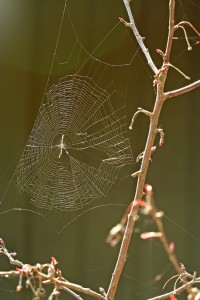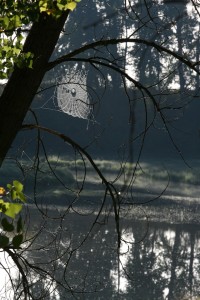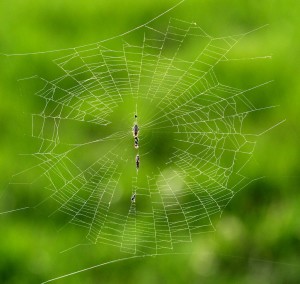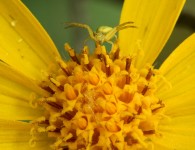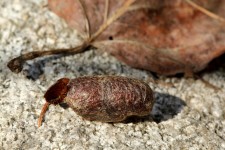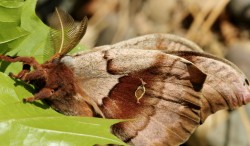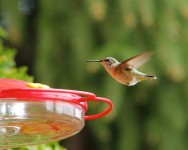Without a single lesson, a young spider can build its own web. As the spider grows, so does the size of the web.
While every spider can produce silk, only 85 percent use silk to spin webbed traps. The two-dimensional orb web is the most recognized web but others include sheet webs, funnel webs and cobwebs.
All spiderwebs are made of silk but not the same type of silk. Spiders can produce up to seven different types of silk, each with a specific purpose. Different silk is used to make egg cocoons, release draglines, wrap prey, and create different parts of a web.
A separate silk gland, located inside the spider’s abdomen, produces each type of silk as a liquid. The silk is drawn out of the abdomen by a leg, breeze or the weight of the spider dropping–it is not squeezed out like toothpaste.
The act of pulling the silk makes it solid, not by contact with air (as demonstrated by spiders that spin webs underwater). Pulling the silk changes the orientation of the fibers and solidifies it.
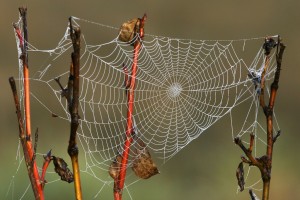
Dew and rain can’t dissolve a spider’s web because the silk is insoluble to water. However, the silk will absorb water and swell.
Silk is pulled from the spider’s abdomen through spinnerets, each one connected to a different silk gland. A spinneret resembles a shower-head with multiple tiny spigots. As the silk emerges from the spigots as extremely fine strands, they combine into a single solid thread.
The diameter of silk is extremely small–0.00012 inches for a garden spider. The average human hair is 0.0039 inches in diameter.
A spider can use between 65 and 200 feet of silk for one web. Spiders will often roll up and eat an old web to conserve protein, as they may spin a new web everyday if the web is damaged.
The average orb web takes approximately one hour to complete. Orb webs are constructed in a very systematic manner.
To begin constructing an orb web, a spider will release a fine silk line into the breeze and wait, as if fishing, until the line touches and adheres to a nearby object. Then the spider will tighten the line and add more strands until the bridge thread is strong enough to support the entire web.
Then the spider makes a separate loose thread between the first two attachment points and moves to the middle of this thread. From there, the spider will attach a new thread and drop down to a lower attachment point, making a “Y” in the process. The “Y” makes the first three spokes of the web.
From the hub (middle of the web), more spokes are added at precise angles, which are measured by the spider’s legs. The spokes of a garden spider’s web are 12 degrees apart. The bridge and spokes are made of non-sticky silk.
Once all the spokes are completed, the spider will start in the middle and add a temporary spiral outward. This spiral is a non-sticky guideline for when the spider returns to the center making a permanent, sticky spiral.
As the spider returns to the center, it will eat the temporary thread while laying down the sticky thread in a spiral. At each spoke, the spider will dab the thread against the spoke and give it a tug so that it breaks up into a line of sticky beads.
The sticky spiral is terminated before the spider reaches the center, so that the spider has room to move in the middle.
When finished, the spider will either settle in at the hub or sit nearby with a “signal thread” held by a front leg to stay in touch with the web. The signal thread enables the spider to feel the vibrations of a captured insect.
Web-spinning spiders are in contact with silk threads virtually their entire life without a single lesson on how to make it work.

